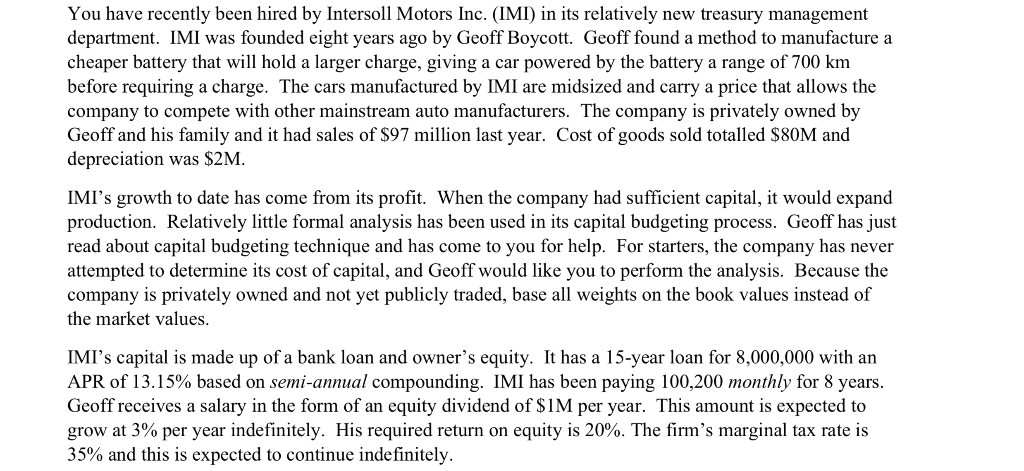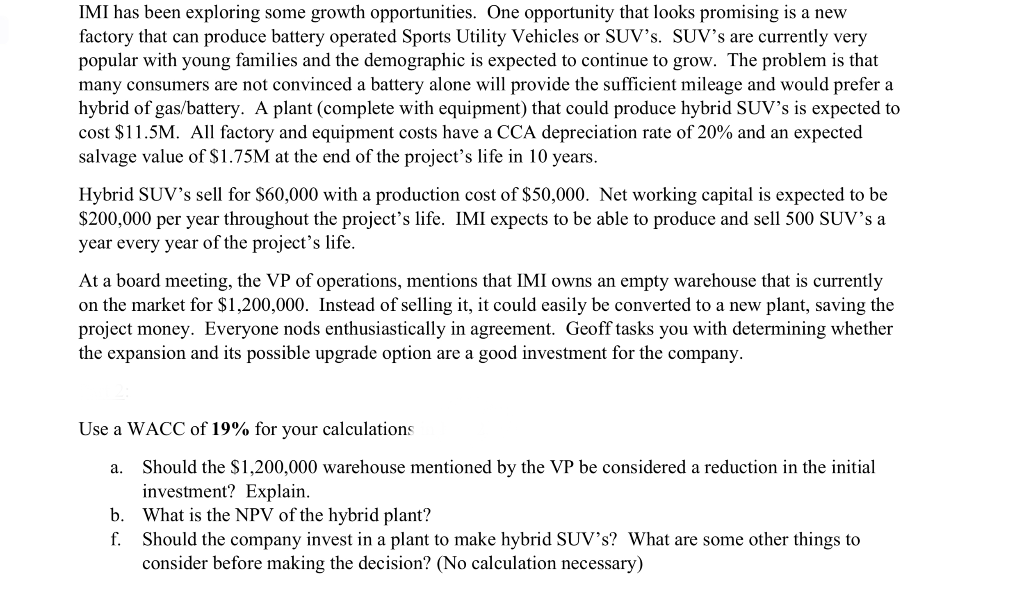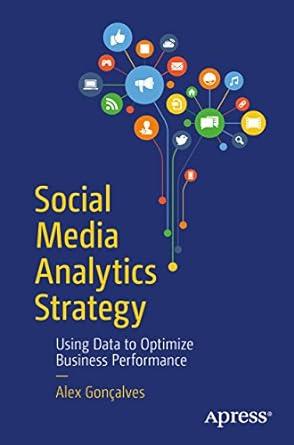

You have recently been hired by Intersoll Motors Inc. (IMI) in its relatively new treasury management department. IMI was founded eight years ago by Geoff Boycott. Geoff found a method to manufacture a cheaper battery that will hold a larger charge, giving a car powered by the battery a range of 700 km before requiring a charge. The cars manufactured by IMI are midsized and carry a price that allows the company to compete with other mainstream auto manufacturers. The company is privately owned by Geoff and his family and it had sales of $97 million last year. Cost of goods sold totalled $80M and depreciation was $2M. IMI's growth to date has come from its profit. When the company had sufficient capital, it would expand production. Relatively little formal analysis has been used in its capital budgeting process. Geoff has just read about capital budgeting technique and has come to you for help. For starters, the company has never attempted to determine its cost of capital, and Geoff would like you to perform the analysis. Because the company is privately owned and not yet publicly traded, base all weights on the book values instead of the market values. IMI's capital is made up of a bank loan and owner's equity. It has a 15-year loan for 8,000,000 with an APR of 13.15% based on semi-annual compounding. IMI has been paying 100,200 monthly for 8 years. Geoff receives a salary in the form of an equity dividend of $1M per year. This amount is expected to grow at 3% per year indefinitely. His required return on equity is 20%. The firm's marginal tax rate is 35% and this is expected to continue indefinitely. IMI has been exploring some growth opportunities. One opportunity that looks promising is a new factory that can produce battery operated Sports Utility Vehicles or SUV's. SUV's are currently very popular with young families and the demographic is expected to continue to grow. The problem is that many consumers are not convinced a battery alone will provide the sufficient mileage and would prefer a hybrid of gas/battery. A plant (complete with equipment) that could produce hybrid SUV's is expected to cost $11.5M. All factory and equipment costs have a CCA depreciation rate of 20% and an expected salvage value of $1.75M at the end of the project's life in 10 years. Hybrid SUV's sell for $60,000 with a production cost of $50,000. Net working capital is expected to be $200,000 per year throughout the project's life. IMI expects to be able to produce and sell 500 SUV's a year every year of the project's life. At a board meeting, the VP of operations, mentions that IMI owns an empty warehouse that is currently on the market for $1,200,000. Instead of selling it, it could easily be converted to a new plant, saving the project money. Everyone nods enthusiastically in agreement. Geoff tasks you with determining whether the expansion and its possible upgrade option are a good investment for the company. Use a WACC of 19% for your calculations a. Should the $1,200,000 warehouse mentioned by the VP be considered a reduction in the initial investment? Explain. b. What is the NPV of the hybrid plant? f. Should the company invest in a plant to make hybrid SUV's? What are some other things to consider before making the decision? (No calculation necessary) You have recently been hired by Intersoll Motors Inc. (IMI) in its relatively new treasury management department. IMI was founded eight years ago by Geoff Boycott. Geoff found a method to manufacture a cheaper battery that will hold a larger charge, giving a car powered by the battery a range of 700 km before requiring a charge. The cars manufactured by IMI are midsized and carry a price that allows the company to compete with other mainstream auto manufacturers. The company is privately owned by Geoff and his family and it had sales of $97 million last year. Cost of goods sold totalled $80M and depreciation was $2M. IMI's growth to date has come from its profit. When the company had sufficient capital, it would expand production. Relatively little formal analysis has been used in its capital budgeting process. Geoff has just read about capital budgeting technique and has come to you for help. For starters, the company has never attempted to determine its cost of capital, and Geoff would like you to perform the analysis. Because the company is privately owned and not yet publicly traded, base all weights on the book values instead of the market values. IMI's capital is made up of a bank loan and owner's equity. It has a 15-year loan for 8,000,000 with an APR of 13.15% based on semi-annual compounding. IMI has been paying 100,200 monthly for 8 years. Geoff receives a salary in the form of an equity dividend of $1M per year. This amount is expected to grow at 3% per year indefinitely. His required return on equity is 20%. The firm's marginal tax rate is 35% and this is expected to continue indefinitely. IMI has been exploring some growth opportunities. One opportunity that looks promising is a new factory that can produce battery operated Sports Utility Vehicles or SUV's. SUV's are currently very popular with young families and the demographic is expected to continue to grow. The problem is that many consumers are not convinced a battery alone will provide the sufficient mileage and would prefer a hybrid of gas/battery. A plant (complete with equipment) that could produce hybrid SUV's is expected to cost $11.5M. All factory and equipment costs have a CCA depreciation rate of 20% and an expected salvage value of $1.75M at the end of the project's life in 10 years. Hybrid SUV's sell for $60,000 with a production cost of $50,000. Net working capital is expected to be $200,000 per year throughout the project's life. IMI expects to be able to produce and sell 500 SUV's a year every year of the project's life. At a board meeting, the VP of operations, mentions that IMI owns an empty warehouse that is currently on the market for $1,200,000. Instead of selling it, it could easily be converted to a new plant, saving the project money. Everyone nods enthusiastically in agreement. Geoff tasks you with determining whether the expansion and its possible upgrade option are a good investment for the company. Use a WACC of 19% for your calculations a. Should the $1,200,000 warehouse mentioned by the VP be considered a reduction in the initial investment? Explain. b. What is the NPV of the hybrid plant? f. Should the company invest in a plant to make hybrid SUV's? What are some other things to consider before making the decision? (No calculation necessary)








